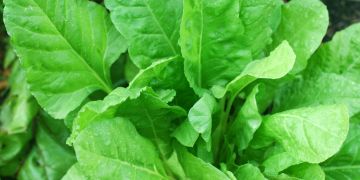While it may not be the greatest tasting food in the world, spinach is very good for you because it's full of vitamins and minerals. It would be a wise idea to incorporate some spinach into your everyday diet. So what exactly can you expect to get out of eating this super-veggie? Read on to find out.
Types of spinach
The three basic types of spinach are
- Savoy which has dark green, crinkly and curly leaves. It is the type sold in fresh bunches in most supermarkets. One heirloom variety of Savoy is Bloomsdale, which is somewhat resistant to bolting. Other common heirloom varieties are Merlo Nero (a mild variety from Italy) and Viroflay (very large spinach with great yields).
- Flat- or smooth-leaf spinach has broad, smooth leaves that are easier to clean than Savoy. This type is often grown for canned and frozen spinach, as well as soups, baby foods, and processed foods. Giant Noble is an example of the variety.
- Semi-Savoy is a hybrid variety with slightly crinkled leaves. It has the same texture as Savoy, but it is not as difficult to clean. It is grown for both fresh market and processing.
Background and Origin
The common flowering-plant known as spinach is first believed to have been included in the diets of ancient Persians and naturally grows in Asia, specifically the central region. Belonging to the Amaranthaceae family, spinach can typically be described as having large, oval-shaped leaves that sprout from a relatively thick, central stalk that has clusters of small flowers growing at the tip. The height of the plant usually maxes out at just over a foot tall, and the leaves can vary greatly in shape. The meaty leaves are the most common part to be eaten, but nearly the entire plant is edible.
Nutritional Content and Health Benefits
Spinach is considered a super-food due to its high nutritional value. First, spinach contains a high amount of beta-carotene, the inactive stage of vitamin A. Beta-carotene is also found in many other leafy greens and yellow, red, and orange fruits and veggies, and it contributes to good vision, healthy skin, a strong immune system, and reproductive system health. When beta-carotene is converted to vitamin A, more moisture is retained in the skin to keep it looking smooth and young.
Another important group of ingredients found in spinach is antioxidants. Antioxidants are believed to reduce the risk of getting cancer, heart disease and premature blindness. In spinach, vitamin E, vitamin C, zinc, beta-carotene, selenium, and manganese are all powerful antioxidants.
The list doesn't stop there as plenty of phytochemicals are also found in Popeye's favorite food. Specifically, lutein helps to lower the risk of losing sight at a faster than normal rate. Other notable vitamins and minerals found in spinach include:iron for hemoglobin production, vitamin C for immune strength, vitamin E for healthy skin, vitamin k for carboxylation and nervous system health, calcium for strong bones, potassium for heart health and normal blood pressure, dietary fiber for easy bowel movements and improved digestion, lipoic acid for the regulation of blood glucose levels and regeneration of various vitamins, and epoxy xanthophylls violaxanthin and neoxanthin for inflammation control.
As far as disease prevention goes, spinach is associated with a lower risk for cardiovascular disease, stroke, hardening of the arteries, high blood pressure, cancer, and more.
Nutritional Content of a 1-cup Serving Size of Raw Spinach
- Calories: 7
- Fat: 0 g
- Saturated Fat: 0 g
- Cholesterol: 0 mg
- Carbohydrate: 1 g
- Protein: 1 g
- Dietary Fiber: 1 g
- Sodium: 24 mg
- Vitamin A: 2,813 IU
- Folic Acid: 58 micrograms
- Vitamin C: 16 mg
- Iron: 1 mg
- Manganese: <1 mg
- Potassium: 167 mg
- Carotenoids: 5,347 micrograms
How to Take
Spinach can be prepared and consumed in a variety of different ways. The most common way to eat spinach is fresh and raw. Like with any other vegetable, all you need to do is rinse the spinach and enjoy it. Raw spinach can be combined with other vegetables and fruits to make a salad. This adds texture, taste, and nutritional value as well. Spinach is also commonly eaten raw as part of a sandwich or blended in a smoothie.
Cooked spinach is commonly eaten in many dishes including pastas and meat dishes as a non-primary ingredient. It can also be served as a side dish to compliment a protein entree. When cooked, spinach wilts dramatically, becomes extremely tender and luscious, and loses much of its vitamin C content. Many people prefer to have it sauteed or steamed as opposed to eating it raw because it can be more flavorful.
If you are really opposed to the taste of spinach, the nutritional benefits can be had in a supplement form. Tablets or capsules are the most common form of supplementation.





